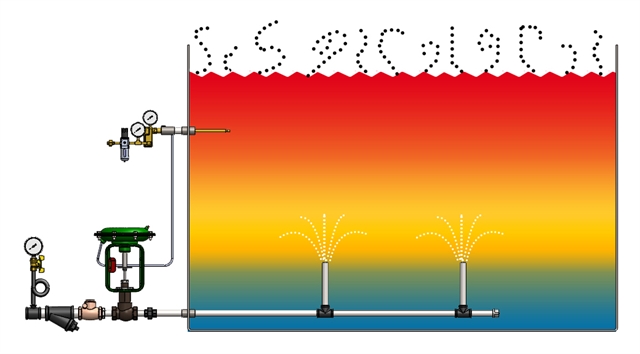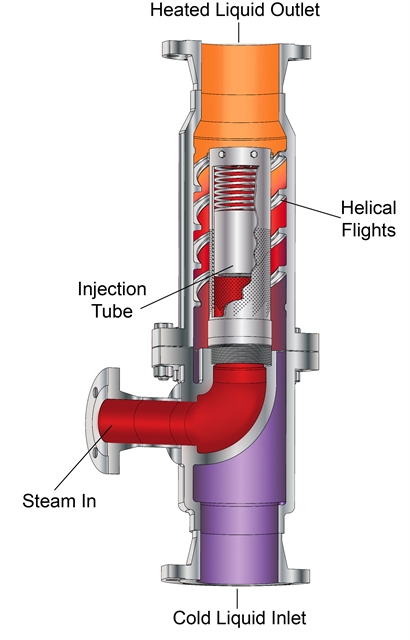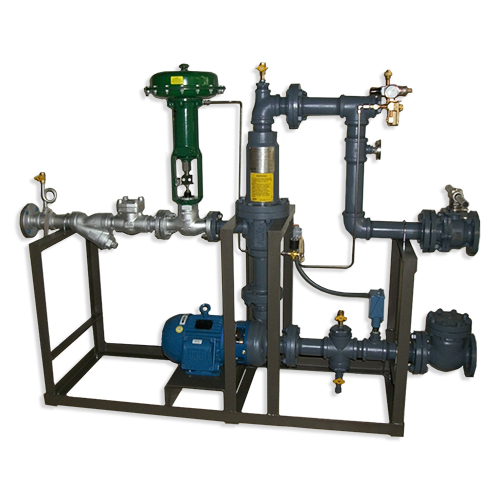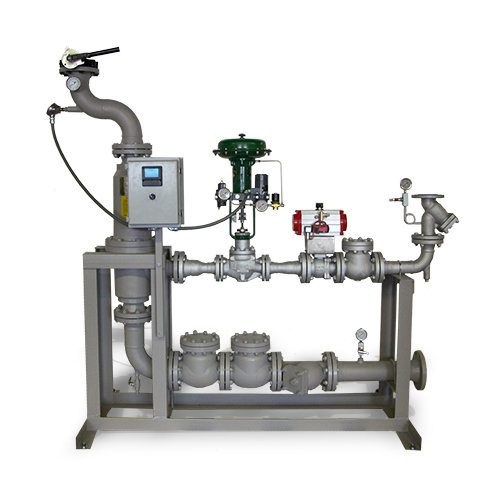Fluids at precisely controlled and elevated temperatures are integral to a wide range of industrial processes. To generate the necessary supply of heated liquid, many plants utilize a simple tank sparging system. In this setup a steam hose or perforated pipe known as a sparger is positioned near the bottom of a tank of liquid or slurry. The sparger injects steam from the plant supply into the tank to heat the liquid. With few components, spargers are easy to make, simple to install and inexpensive. They are, however, plagued by a number of issues, including energy inefficiencies, steam hammer, poor temperature control, and damage to the tank or equipment.
Fortunately, a better industrial liquid heating system exists. The Pick In‐Line Direct Steam Injection Heater is a direct, in‐line steam injection heating device that instantly heats liquids with one hundred percent efficiency, eliminates steam hammer and offers exceptional temperature control.
The secret to the Pick Heater’s superior performance lies in its unique design. Two inlet ports direct channel separate flows of steam and unheated liquid toward the heart of the device where a steam injection tube and piston are located. The injection tube consists of hundreds of small orifices through which steam is dispersed into the liquid.
In response to changes in steam flow, a spring‐loaded piston rises or falls, exposing or covering orifices to maintain a differential between the steam and water pressures, thereby preventing steam hammer and eliminating harmful shock and vibration. The piston will also close during shutdown to prevent sudden collapse of steam inside the tube. Helical flights in the chamber ensure thorough mixing prior to discharge of the heated liquid.
The result is many reasons to replace tank spargers with Pick Heaters.

Figure 1. Inefficient spargers inject steam into the tank reservoir.
1. Improve Energy Efficiency
One of the most significant advantages is the energy savings that can be realized with the Pick. Heating liquids with spargers is an inefficient process because not all of the injected steam bubbles condense into the liquid being heated. Some of the hot steam bubbles remain uncondensed, rising to the top of the tank to escape to the atmosphere, wasting energy. The problem is most pronounced as the liquid’s temperature rises. When the liquid is hot, the rate at which steam condenses into the liquid decreases and the steam bubbles do not have enough time to condense before they reach the surface.
The Pick Heater, in contrast, operates with 100 percent efficiency, thoroughly mixing the steam and liquid under pressure to ensure that all of the steam is condensed. None of the energy consumed to generate the steam is wasted; effectively, all of the British Thermal Units (BTUs) are absorbed by the liquid, reducing energy costs.
2. Eliminate Steam Hammer
A common issue encountered when heating liquids with tank spargers is the potential for damage to the tank and piping from steam hammer. This condition occurs when uncondensed steam bubbles collapse upon contact with cold tank or pipe walls. Water rushes in to fill the void of the collapsed bubble, crashing into the wall. The resulting force and vibration can damage tank walls and welds.
With the Pick Heater, on the other hand, steam hammer is not a concern. The Pick's unique variable orifice injector automatically maintains a minimum differential between the steam and water pressures. Inside the heating chamber, steam is rapidly and completely condensed and thoroughly mixed into the process liquid. Complete condensation and mixing of the steam with the liquid ensures a stabilized heating process that results in fewer process upsets, more reliable heating and fewer energy losses.

Figure 2: Cutaway of a Pick In‐Line Direct Steam Injection Heater.
3. Precisely Control Temperature
Another problem with tank spargers is that they struggle to provide accurate control of process liquid temperature. The uncontrolled nature of the steam bubbles causes some energy to be lost to the atmosphere or condense downstream in piping, resulting in temperatures that deviate from the desired design target. In addition, spargers have a tendency to produce hot and cold zones within a tank due to incomplete steam and liquid mixing. Since tank temperature is often monitored at only one location with a single temperature sensor, this can lead to inaccurate temperature readings if the sensor and process liquid outlet are in different positions.
By contrast, the Pick Heater delivers accurate temperature control throughout the entire operating range to assure product quality. Rapid and complete mixing of the steam and liquid within the heating chamber allows the Pick to adapt quickly to load changes and maintain precise temperature control to within 1.8 degrees Fahrenheit (1 degree Celsius).
4. Get Rid of Storage Tanks
Many industrial processes require specific batch or continuous flow volumes of liquid at precise temperatures. The relatively slow heating rate of spargers is often insufficient to meet this requirement in an in‐line, on‐demand configuration. Instead, tank spargers slowly heat a large volume of liquid contained in a storage tank to ensure that enough liquid can be supplied at the right temperature when needed.
By replacing spargers with a Pick Heater, storage tanks and slow batch processing can be eliminated. The Pick is in‐line and truly instantaneous, capable of delivering an endless supply of hot liquid on demand. There is no waiting around for a tank of liquid to reach the correct temperature. Heating, cooking or sterilization can be carried out continuously, enabling higher production volumes in less time than other heating methods.

Figure 3: A Pick Direct Steam Injection Heater is featured in this
packaged system for heating a storage tank in a food plant.
5. Extend Operating Temperature Range
Tank spargers heating liquid in an open tank suffer from a limited operating temperature range and decreasing efficiency as the temperature rises. This is because, as the temperature rises, increasingly larger amounts of steam remain uncondensed in bubbles that are lost to the atmosphere. Spargers are incapable of raising the liquid’s temperature past its normal boiling point. At that point, heating efficiency hits zero as all steam is lost to the atmosphere.
The Pick Heater, conversely, has unlimited turndown in both process flow rates and heat load, and can heat water above its normal boiling point. The reason is that the steam and liquid are under pressure during all stages of the heating process — at the inlet, in the heating chamber and downstream. With 100 percent of the steam condensing into the water, efficiency remains high throughout an extended operating temperature range.
Superior Heating
Compared to tank sparging, the Pick In‐Line Direct Steam Injection Heater provides superior mixing of steam and process fluids, minimizing steam usage and energy costs. But an even bigger advantage is, perhaps, the reduction in the time it takes to heat water from a cold start to the desired process temperature. This time savings can dramatically improve production capacity.
With improved energy efficiency, lack of steam hammer issues, accurate temperature control, no need for storage tanks and extended operating range, the Pick Heater is an ideal replacement for tank spargers.

Figure 4: This scrubber wash system contains a Pick In‐Line Direct Steam Injection Heater.
For more information, contact us.